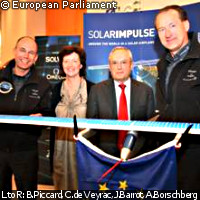Solar Impulse aircraft demonstrates clean mobility
A manned aeroplane capable of flying day and night on solar energy alone may sound like science fiction, but partners in the Solar Impulse project hope that it will soon become tomorrow's reality. The Swiss-led project was presented at a seminar 'Towards a more sustainable aviation' at the European Parliament on 9 April, where it received the official backing of the European Commission. The aircraft prototype, which is currently being built in Germany, looks similar to a glider with wide wings and a thin light body. To capture sufficient sunlight, the ultra-light aircraft is as wide as a jumbo jet, with wings measuring 61 metres across. However, compared to a jumbo jet, the plane is much lighter, weighing in at 1,500 kilos. Never before has an aeroplane succeeded in flying with these size, weight and speed characteristics. In terms of autonomy, the prototype is expected to be able to capture enough sunlight to make a 36-hour flight. To do so, it will harvest energy from 200 square metres of mono-crystalline silicon photovoltaic cells situated on the wings of the craft. Each cell can provide the aircraft's propeller with 30 watts of continuous energy. With 12% total efficiency, the aircraft's motors will be able to achieve around between 8 and 12 horse power - the equivalent amount of power the Wright brothers had available to them in 1903 when they made their first powered flight - and an average speed of 70 kilometres per hour. Under the wings are four gondolas, each containing a motor, a lithium polymer battery, and a management system to control the temperature of the aircraft. The thermal insulation has been designed to conserve heat radiated by the batteries and keep them functioning despite the frosty conditions encountered at 8,500 metres, the maximum altitude of the aircraft. Virtual test flights on the prototype are scheduled for early 2009 to validate the selected technologies and construction processes. These will involve taking a computer model of the aircraft through simulated conditions modelled on real weather data. A second aircraft will then be developed with the wingspan of 80 metres (as wide as the wings of the Airbus A380), to fly several 24-hour cycles. If all goes to plan, in 2011, the aircraft will be ready for the first-round-the-world trip, which will be made in five legs. Swiss adventurers Dr Bertrand Piccard, the initiator of the project, and André Borschberg, the project's CEO, will take turns in piloting the aircraft during the trip. Speaking at the Brussels seminar, Dr Piccard said that the ambitious €70 million project, which is financed by private funds, was helping to disprove the preconceived notion that the world will never be able to free itself from its dependence on fossil fuels. 'There have always been people saying that progress isn't possible,' Dr Piccard said, pointing to how people were condemned as heretics for arguing that the world was not flat, but round. Mr Piccard says that one day soon we will laugh about our belief that there is no future without fossil fuels, just like we laugh about those who believed the earth was flat. With energy prices continuing to rise, people will be forced to change their minds and see that renewable energies are a feasible part of the solution. Political will is also needed, said Dr Piccard, who thanked the European Commission for lending its support to the project. 'I admire those who have the political courage to force our society to extract itself from its dependency on fossil fuels. By becoming a symbol of Europe's commitment to clean mobility, Solar Impulse undertakes to do its bit to convey renewable energies as an opportunity that should not pass us by,' he said. Jacques Barrot, Vice-President of the European Commission and Transport Commissioner, who also attended the seminar, said he did not have to think twice before giving his patronage to this 'audacious' project. 'A world without the aeroplane is unimaginable. But we still do not have a blueprint for the aeroplane of the future, an environmentally-friendly aeroplane. Taking today's technologies and materials to their limits and beyond to accelerate the emergence of tomorrow's technologies is the challenge embodied by the Solar Impulse project,' said the Vice-President. 'The aircraft serves as a symbol of what the future of sustainable transport should look like,' he added. MEP Christine de Veyrac, who organised the seminar, agreed that the project was proof that mobility and respect for the environment could be reconciled. 'This project should not only spawn technological advances due to the innovations necessary for its success, but also raise awareness among Europeans of the need to respect the environment and put the spotlight on the problem of depleting energy resources,' she said. The EU is also trying to move aviation into a new phase of technological development. It recently launched the €1.6 billion Clean Sky initiative, the goal being to improve the environmental performance and competitiveness of Europe's aeronautics industry by developing 'cleaner, more competitive technologies'. The initiative, which is a public-private partnership between industry, the research community and the European Commission, will invest in research and innovation with the goal reducing carbon dioxide (CO2) emissions by 40%, nitrous oxide (NOx) emissions by 40% and noise emissions by the order of 20 decibels. It is hoped that these advances will be made in time for the next generation of aircraft to enter into service from 2015.
Countries
Switzerland



